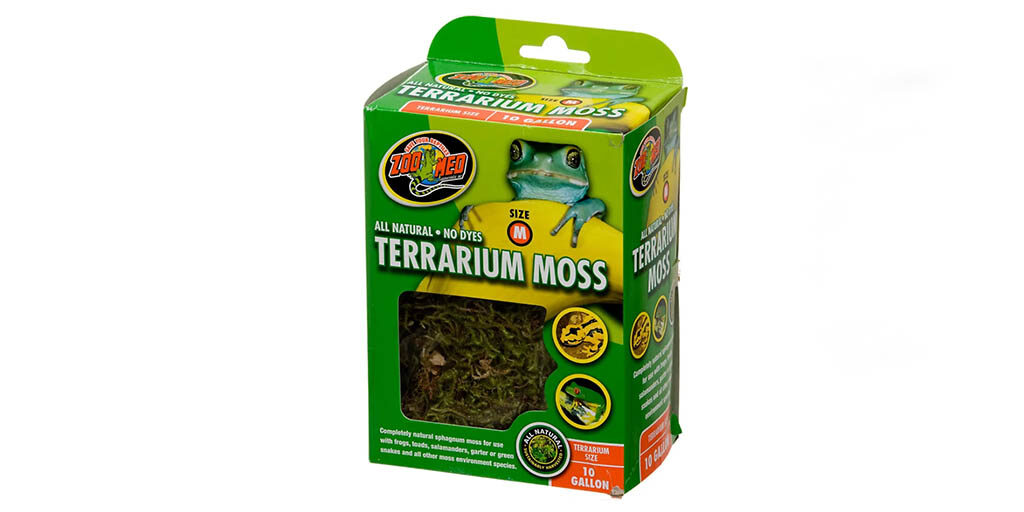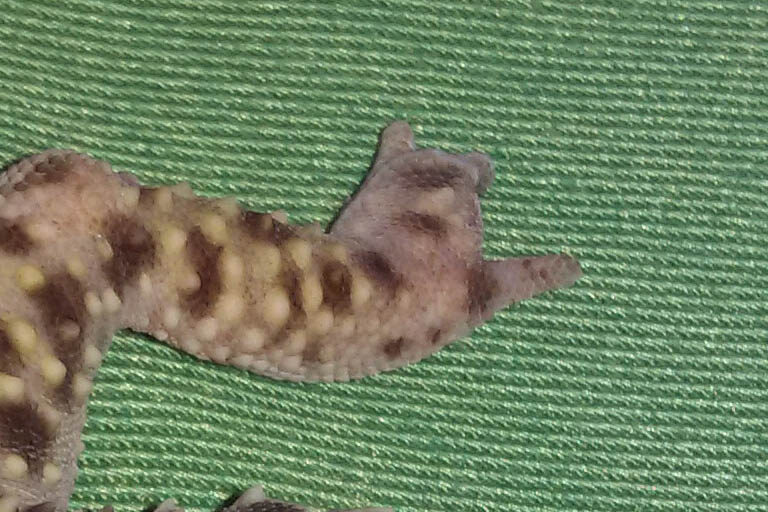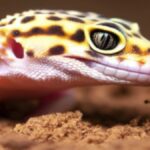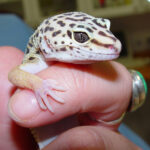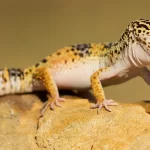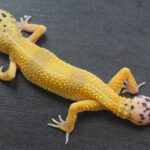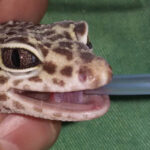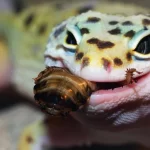Problematic skin shedding is commonly encountered with low humidities. There are typical signs and solutions for skin shedding problems in Leopard geckos.
Introduction to skin shedding problems in Leopard geckos
Abnormal skin shedding is commonly seen in Leopard geckos and is called dysecdysis(32)(54).
Leopard geckos shed the outer parts of their skin as they grow(32). Skin shedding (also called ecdysis(54), moulting(54) or sloughing(54)) is seen from time to time and is more frequent in baby and juvenile Leopard geckos.
Old skin is typically sloughed every 10 to 14 days in baby and juvenile Leopard geckos and every 4 to 8(32) weeks in adults. During the shedding process, the skin will turn dull(57) (white to grey) after which pieces will start to become loose and peel off.
Leopard geckos will often eat their sloughed skins(32)(54).
Unlike some other lizards, Leopard geckos will often shed their skin in one complete piece(54), but shedding can also happen in a couple of large pieces. The active skin shedding process will take place over a short period of time (one to two hours in Leopard geckos(32)).
By keeping records, normal patterns, frequencies and durations of a Leopard gecko’s skin sheddings can be monitored for abnormalities.
Also see
Leopard gecko skin shedding — an ‘a pealing’ affair
Skin eating behaviour in Leopard geckos
Abnormal skin shedding in Leopard geckos (dysecdysis)
There are various reasons for Leopard geckos not to shed their skins normally.
In the author’s experience, most shedding problems in Leopard geckos are due to incorrect husbandry (mainly environmental humidity and temperature). Other contributing factors include health problems (such as skin infections and hypovitaminosis A), skin parasites, stress, injuries and excessive handling during the shedding period.
By knowing what normal skin shedding looks like, abnormal or difficult skin shedding can be identified.
Also see
Handling a Leopard gecko
Signs of abnormal skin shedding
Abnormal skin shedding in Leopard geckos is evident by one or more of the following:
- Prolonged skin shedding (i.e. taking longer than a couple of hours for the entire skin to come off)
- Partial shedding (i.e. the skin is peeling off in multiple small pieces and some pieces still stay behind on the body)
- Prolonged periods between one skin shed to the next
Environmental problems
Environmental problems leading to abnormal skin shedding in Leopard geckos include incorrect humidities and temperatures(62) and are often due to incorrect husbandry. Ambient temperature and humidity are also reported in the literature to possibly have an effect on the frequency of ecdysis(55).
Humidity
The humidity is probably the most frequently reported reason for skin shedding problems in Leopard geckos. A low humidity (i.e. a too dry environment) prevents old skin from loosening properly, leading to pieces remaining stuck on the body(30).
In cases where the humidity is too low, Leopard geckos will often struggle with prolonged and partial skin shedding. It is often observed by Leopard geckos spending more time soaking in their water dishes.
To overcome most humidity-related problems, one or more humidifying shelters need to be supplied(30). Humidifying shelters can be commercial or home-made and is usually in the form of an enclosed hide box with a moist substrate.
Zoo Med has an all-natural, sustainably harvested Sphagnum moss that contains no dyes or chemicals. Sphagnum moss is ideal to use as a substrate for humidifying shelters. Available from Amazon.com
Also see
Leopard gecko hide areas and hide boxes
Leopard gecko soaking — warning signs
Temperature
Leopard geckos will thrive in temperatures of 25–30 ºC / 77–86 ºF(23) with a drop to room temperature during the evenings. Temperatures can be measured using a thermometer.
When the environmental temperature is too low, it can lead to chronic stress, retarded growth and diseases. Too high temperatures will have a decreasing effect on the environmental humidity and can also be seen as Leopard geckos spending more time soaking in their water bowls.
Also see
Supplying heat to pet Leopard geckos
The frequency of normal skin shedding in Leopard geckos is mainly dependant on factors such as growth rate, the season, hibernation (brumation), mating(54) and nutritional status.
Additional factors contributing to the frequency of normal skin shedding in Leopard geckos include the reproductive status, parasite load, hormonal balance and infection with bacterial or other skin pathogens(55).
Malnourishment
Malnourished Leopard geckos will show prolonged skin shedding and prolonged periods between sheds. The nutritional status will be dependant on correct feeding and the health status of the Leopard gecko.
It was observed medically by some authors that severely malnourished lizards appear to have very difficult and irregular sloughs(55). This might be due to the fact that hypoproteinemic animals are unable to produce the full complement of enzymes necessary to complete the breakdown between new and old skin(55).
Hypovitaminosis A
Vitamin A deficiency has been reported to contribute to dysecdysis in Leopard geckos(30)(32)(62). Apart from problematic sheds, a deficiency in vitamin A also leads to other eye-related problems such as keratitis, conjunctivitis, blepharitis, and periocular abscesses. Chronic cases can result in dry eye with subsequent corneal scarring and blindness(30).
Crickets are unable to store vitamin A making Leopard geckos sustained on a non-gut-loaded, non-supplemented diet of crickets prone to develop this condition. Hypovitaminosis A results in squamous metaplasia of epithelium, which reduces fluid secretion by the skin and affects the separation of the old and new layers(32).
Note that it is also easy to overdose Leopard geckos with vitamin A, which leads to iatrogenic skin pathology. Gradual replenishment of vitamin A stores using the correct nutrition and long-term low dose oral supplementation is the safest treatment of hypovitaminosis A(32).
Complications of dysecdysis
Abnormal skin shedding in Leopard geckos is associated with many potential problems. A major problem includes the constriction of toes, parts of the tail, legs and feet(32). Unslaughed skin that remains in these areas has a restriction effect (almost like a tourniquet) due to the expansion of the area underneath.
Areas/extremities distal to constrictions are deprived of normal blood flow and are ultimately at risk for avascular necrosis(32) and detachment if not treated.
Leopard gecko foot missing multiple toes due to skin constrictions and avascular necrosis secondary to dysecdysis. Image © Renier Delport
Another complication due to dysecdysis in Leopard geckos is secondary skin, mouth and eye infections(32). Retained skin can serve as growing sites for various types of fungi and bacteria(32). When the areas around the eyes are affected, keratitis and conjunctivitis are commonly seen(32).
Treating skin shedding problems in Leopard geckos
The treatment of Leopard gecko shedding problems is threefold:
- remove the remaining skin
- treat the underlying cause
- treat the complications
In Leopard geckos, dysecdysis is almost always the consequence of other problems. Identifying these problems is often more important than identifying the shedding problem itself.
Immediate home management includes increasing the humidity by either increasing the size of the water bowl and/or adding a hide box with a moist substrate (aka humidifying shelter).
Starting when the skin turns dull, the shedding process of Leopard geckos can also be helped by daily gentle misting of the enclosure and daily lukewarm baths in a shallow container. The water temperature used for bathing/soaking and misting should be in the desired temperature range of Leopard geckos (25–30 ºC / 77–86 ºF(23)). A thermometer can be used to measure the temperature of the water.
Also see
Leopard gecko hide areas and hide boxes
Leopard gecko thermometers
Correct humidity for Leopard geckos
If the shedding problems persist, reoccurs and/or there are already pieces of skin stuck to the body, professional help is indicated. Leopard geckos with persistent shedding problems should be evaluated by a reptile friendly veterinarian.
In the case where pieces of skin are stuck around the toes, feet or tail it can be removed by soaking the affected area in lukewarm warm water and gently teasing loose fragments away with damp cotton buds and atraumatic forceps(32). Pieces around the eyes can also be removed this way, but these areas often require additional medicines against eye infections(32).
Hypovitaminosis A is treated by 0.01 mL of vitamin A/D (500 000 IU/ml vitamin A) SC, repeated in two weeks. The diet should also be corrected(30).
Conclusion
Although the most common reason for skin shedding problems in Leopard geckos is often the result of incorrect husbandry, other, even more, serious factors can play a role. In persistent cases where potential environmental problems have been resolved, professional help is indicated.

